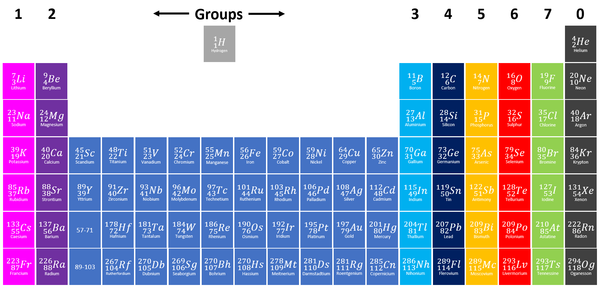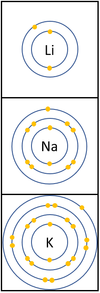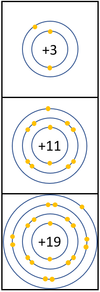Difference between revisions of "Group 1"
| Line 59: | Line 59: | ||
:[https://www.amazon.co.uk/gp/product/1292120193/ref=as_li_tl?ie=UTF8&camp=1634&creative=6738&creativeASIN=1292120193&linkCode=as2&tag=nrjc-21&linkId=572df39392fb4200db8391d98ae6314e ''Alkali metals, pages 242-243, GCSE Combined Science, Pearson Edexcel ''] | :[https://www.amazon.co.uk/gp/product/1292120193/ref=as_li_tl?ie=UTF8&camp=1634&creative=6738&creativeASIN=1292120193&linkCode=as2&tag=nrjc-21&linkId=572df39392fb4200db8391d98ae6314e ''Alkali metals, pages 242-243, GCSE Combined Science, Pearson Edexcel ''] | ||
:[https://www.amazon.co.uk/gp/product/1782948147/ref=as_li_tl?ie=UTF8&camp=1634&creative=6738&creativeASIN=1782948147&linkCode=as2&tag=nrjc-21&linkId=f63dcd8345f4e49c717b39a228a36c7c ''Alkali metals, pages 40, 49, 210-212, GCSE Chemistry, CGP, Edexcel ''] | :[https://www.amazon.co.uk/gp/product/1782948147/ref=as_li_tl?ie=UTF8&camp=1634&creative=6738&creativeASIN=1782948147&linkCode=as2&tag=nrjc-21&linkId=f63dcd8345f4e49c717b39a228a36c7c ''Alkali metals, pages 40, 49, 210-212, GCSE Chemistry, CGP, Edexcel ''] | ||
| + | :[https://www.amazon.co.uk/gp/product/1471851354/ref=as_li_tl?ie=UTF8&camp=1634&creative=6738&creativeASIN=1471851354&linkCode=as2&tag=nrjc-21&linkId=9012a0d354024419214fb3ad5ac44ba0 ''Group 1 (alkali metals), pages 129-31, GCSE Combined Science Trilogy 1, Hodder, AQA ''] | ||
| + | :[https://www.amazon.co.uk/gp/product/0008158762/ref=as_li_tl?ie=UTF8&camp=1634&creative=6738&creativeASIN=0008158762&linkCode=as2&tag=nrjc-21&linkId=a0fffa35b3ea49a63404f6704e0df7cc ''Group 1 (alkali metals), pages 42-3, 46, 49, 42-3, 131, 133-5, GCSE Chemistry; Student Book, Collins, AQA ''] | ||
| + | :[https://www.amazon.co.uk/gp/product/1471851354/ref=as_li_tl?ie=UTF8&camp=1634&creative=6738&creativeASIN=1471851354&linkCode=as2&tag=nrjc-21&linkId=9012a0d354024419214fb3ad5ac44ba0 ''Group 1 (alkali metals); physical properties, page 162, GCSE Combined Science Trilogy 1, Hodder, AQA ''] | ||
| + | :[https://www.amazon.co.uk/gp/product/1782945598/ref=as_li_tl?ie=UTF8&camp=1634&creative=6738&creativeASIN=1782945598&linkCode=as2&tag=nrjc-21&linkId=ad276ad49df77ab4b40ab4fd0fe09971 ''Group 1, page 109, GCSE Combined Science; The Revision Guide, CGP, AQA ''] | ||
| + | :[https://www.amazon.co.uk/gp/product/1782945571/ref=as_li_tl?ie=UTF8&camp=1634&creative=6738&creativeASIN=1782945571&linkCode=as2&tag=nrjc-21&linkId=9e29fad914244909903e5e93f8a01d146 ''Group 1, page 24, GCSE Chemistry; The Revision Guide, CGP, AQA ''] | ||
| + | :[https://www.amazon.co.uk/gp/product/1471851346/ref=as_li_tl?ie=UTF8&camp=1634&creative=6738&creativeASIN=1471851346&linkCode=as2&tag=nrjc-21&linkId=3ac654f4b0da781c49c855a1af4c92ea ''Group 1, pages 14-15, GCSE Chemistry, Hodder, AQA ''] | ||
| + | :[https://www.amazon.co.uk/gp/product/0198359381/ref=as_li_tl?ie=UTF8&camp=1634&creative=6738&creativeASIN=0198359381&linkCode=as2&tag=nrjc-21&linkId=47c8d1ae58d8b3a5e2094cd447154558 ''Group 1, pages 26-27, 30-31, GCSE Chemistry; Third Edition, Oxford University Press, AQA ''] | ||
| + | :[https://www.amazon.co.uk/gp/product/1782945962/ref=as_li_tl?ie=UTF8&camp=1634&creative=6738&creativeASIN=1782945962&linkCode=as2&tag=nrjc-21&linkId=476bb5c8d1dfb5c08ac81b6d4d1c98d8 ''Group 1, pages 56-58, 66, GCSE Chemistry, CGP, AQA ''] | ||
| + | :[https://www.amazon.co.uk/gp/product/178294639X/ref=as_li_tl?ie=UTF8&camp=1634&creative=6738&creativeASIN=178294639X&linkCode=as2&tag=nrjc-21&linkId=51599bb45a2bfaf7c1b6a978b2ca2616 ''Group 1, pages 56-58, GCSE Combined Science Trilogy; Chemistry, CGP, AQA ''] | ||
Revision as of 07:59, 6 November 2019
Contents
Key Stage 4
Meaning
Group 1 elements, also known as Alkali Metals on the Periodic Table are the elements which have only one electron in their outer shell.
| Group 1 elements are shown in light purple at the far left of the Periodic Table. NB: Hydrogen is often shown in Group 1 due to having a single electron in the outer shell however it is not considered an Alkali Metal because it has very few properties in common with Alkali Metals. |
About the Alkali Metals
- Though Hydrogen has one electron in the outer shell it does not behave the same as other elements in group 1 so it is not considered to be an Alkali Metal.
- The Alkali Metals have similar chemical properties because they all have one electron on their outer shell.
- Alkali Metals all produce ions with a +1 relative charge because they lose an electron in chemical reactions.
The Alkali Metals in order from least reactive to most reactive are:
Chemical Properties
- Alkali Metals are all highly reactive and will oxidise quickly in the presence of Oxygen.
- Alkali Metals all react strongly with water to produce metal hydroxides and Hydrogen gas.
- Alkali Metals all produce strong alkalis.
| In a chemical reaction the electron in the outer shell is lost.
The reactivity increases as you go down the group because:
|
Physical Properties
- Alkali Metals have a low density compared to other metals.
- Alkali Metals are all solid at room temperature but have a low melting point compared to other metals.
- Alkali Metals are soft and can be easily cut.
- Alkali Metals all appear shiny (before they oxidise).
References
AQA
- Alkali metals (Group 1), pages 14-15, GCSE Chemistry, Hodder, AQA
- Alkali metals, page 109, GCSE Combined Science; The Revision Guide, CGP, AQA
- Alkali metals, page 24, GCSE Chemistry; The Revision Guide, CGP, AQA
- Alkali metals, pages 129-31, GCSE Combined Science Trilogy 1, Hodder, AQA
- Alkali metals, pages 26-27, 30-31, GCSE Chemistry; Third Edition, Oxford University Press, AQA
- Alkali metals, pages 56-58, GCSE Combined Science Trilogy; Chemistry, CGP, AQA
- Alkali metals, pages 56-59, 66, GCSE Chemistry, CGP, AQA
- Alkali metals, physical properties, page 162, GCSE Combined Science Trilogy 1, Hodder, AQA
Edexcel
- Alkali metals, page 123, GCSE Combined Science; The Revision Guide, CGP, Edexcel
- Alkali metals, page 73, GCSE Chemistry; The Revision Guide, CGP, Edexcel
- Alkali metals, pages 128-129, GCSE Chemistry, Pearson, Edexcel
- Alkali metals, pages 242-243, GCSE Combined Science, Pearson Edexcel
- Alkali metals, pages 40, 49, 210-212, GCSE Chemistry, CGP, Edexcel
- Group 1 (alkali metals), pages 129-31, GCSE Combined Science Trilogy 1, Hodder, AQA
- Group 1 (alkali metals), pages 42-3, 46, 49, 42-3, 131, 133-5, GCSE Chemistry; Student Book, Collins, AQA
- Group 1 (alkali metals); physical properties, page 162, GCSE Combined Science Trilogy 1, Hodder, AQA
- Group 1, page 109, GCSE Combined Science; The Revision Guide, CGP, AQA
- Group 1, page 24, GCSE Chemistry; The Revision Guide, CGP, AQA
- Group 1, pages 14-15, GCSE Chemistry, Hodder, AQA
- Group 1, pages 26-27, 30-31, GCSE Chemistry; Third Edition, Oxford University Press, AQA
- Group 1, pages 56-58, 66, GCSE Chemistry, CGP, AQA
- Group 1, pages 56-58, GCSE Combined Science Trilogy; Chemistry, CGP, AQA


